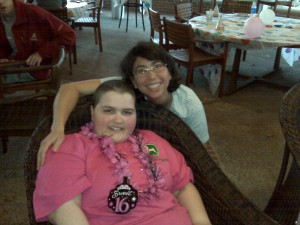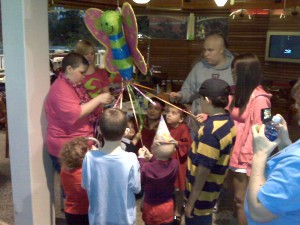After days of struggling with the aftermath of chemo, Colin started to perk up a bit, so he emerged from the hospital after 25 days. Of course, he has very happily been out of the hospital during that time, yet not technically an outpatient.
The whole process was a little confusing, as Dr. DeWire told us she hoped that Colin would get out by the weekend; within an hour or so, we were told that Colin would get discharged that day. We were cross-eyed by the mixed signals yet, understanding the acute need for beds here. Reluctant to be the recalcitrant patient that denied another chemo, we went along with the plan. After all, though not totally in the pink, Colin was much improved.
The weekend had been absolute misery for Colin, who spent his days feeling sick or zonked out. Click here for a video of Colin chemoed out, which he repeatedly asked to see again. Monday was a bit better though the vomiting was far from over. Instead, his highs were a little higher and his lows not quite as pathetic.
Colin woke up on Tuesday morning full of vim and vigor yet has shown us that these periods of energy and playfulness do not mean that he won’t later succumb to the woes of chemo. Thus, we were a bit guarded about his prospects for remaining quite so perky.
We ended up leaving the hospital aiming for the 6 p.m. shuttle back to Target House, where we met up with the home health agency to do intake. Dad had a chance to take Colin over to Target House II, where he got to mingle and, most particularly, see his friend Carissa.
Randomly Ordered Weekend Recap
Unfortunately, Colin had missed Carissa’s (Sweet 16!) birthday party on Sunday.

Aidan was a terrible proxy and had spent most of his time trying to run in circles and generally avoided the more grown up activities.
Even so, it was a great opportunity to celebrate with Carissa and see many of the other Target House families that we know. It ends up being like a family reunion where you’re not sure how you’re related to this cousin or that in-law but you always run into people you know in common.
For me, it was particularly interesting to spend a bit of time with some of the teens. As much as we hate to see Colin go through cancer treatment at two, it seems so much more difficult for the older kids. These young people, who are in the process of defining themselves, find themselves instead to be railroaded by cancer and redefined by terms they have not chosen.
The kids respond differently to this, yet one universal is that they do not want cancer to overshadow them. It is an understandable struggle, especially when struggle itself characterizes the teenaged years.
 Pinata pulling at Carissa’s birthday party
Pinata pulling at Carissa’s birthday partyI sat with Carissa and some of her peers when the subject of surgery came up. It wasn’t clear to me what role two of the girls played (friends? patient siblings?), as they seemed like normal disaffected teenagers. One young lady opined that she dreaded the idea of another surgery, since the first left a large scar on her scalp.
She drew a line through her hair with her finger, and I pointlessly but reflexively noted that it must have been a supratentorial tumor. I asked when the surgery had been. March or April of 2009, recent enough that her hair couldn’t have grown back.
“Did they shave very carefully along the incision line?” I asked.
“Oh, this is a wig.”
I was suddenly struck by the fact that I had become accustomed to bald and fuzzy headed shorties who are assumed to have no vanity about things like hair. Carissa herself, who had quite long hair before treatment, takes no pains to conceal her scalp, though her hair has since started growing in nicely.
We have paid little attention to the effects of cancer treatment on a child’s self esteem and body image because it didn’t seem especially relevant in Colin’s case. Even if he cares, which he seems to at least to some degree, our response is more rudimentary than anything.
For example, he recently explored his shunt with his fingers, feeling the hard curve hiding under his scalp. I explained that it was to help keep the bad headaches away and that it goes all the way to his stomach. The tubing for the VP shunt is palpable below the skin and, with his platelet count low, has now shown itself as a faint curved bruise shaped on his right abdomen.
In addition to the party, Colin had also missed (though he probably wouldn’t have understood the point) Aidan’s performance in Play in a Day, a two-day exercise in which kids compose their own play and then give a performance. It’s a wonderful opportunity for these children, both patients and siblings, to control something in their out-of-control lives. It’s also perfect for a child like Aidan, who does better in smaller groups (there were three other participants) and really got into his role.
Aidan was the Turtle King, a snapping turtle who stayed in character by “snapping” at anything that came near him. His costume was more Elton John than Yertle, with tinted sun glasses and glove epaulets on his shoulders. This latter bit was Aidan’s idea, as the gloves did not fit on his hands.
16 Hours
Early Wednesday morning, Colin’s heart rate was high enough to set off the alarm on the pulse-oximeter. A dose of morphine failed to calm him, and when we went in, his nurse pointed out that he didn’t look quite right.
We are thankful that the agency has been careful to send the same person as much as possible, and she now knows Colin, even though he has been outpatient relatively little in the past month. She recognized that his nose and hands were dusky, the kind of visual sign that we are not keen to spotting.
It was neither alarming nor normal to see him laboring to breathe and clearly uncomfortable, so we called the Medicine Room and were instructed to come in as soon as possible. This ended up being a confusing order, since they were unable to see us there, so instead we embarked on our original appointments, starting with Assessment & Triage for labs.
Dr. DeWire, hearing of Colin’s respiratory symptoms, also ordered an x-ray, which was performed in short order. We continued on to our regular appointments, which really only included a portion of speech therapy, before heading off to our clinic and a visit with our doctors.
Dr. Gajjar looked stern and concerned (probably these two emotions look fairly similar on him) and wasted no time in proclaiming, “Bring him in.” When Dr. DeWire asked Colin if he wanted to go upstairs, he nodded, though I’m not sure if he knew what he was assenting to.
They gave him morphine through the I.V. while we waited to go upstairs and discussed his condition, which was in some ways good (lungs = clear) but in other ways still out of whack (magnesium = “critically” low; platelets = 34). On Thursday, the magnesium was fine, but the potassium was again low, and his hemoglobin had dropped enough to warrant another blood transfusion. His secretions increased markedly and we have been suctioning him like crazy, but after much contemplation we think it may be related to the vincristine he recently received, which can cause vocal cord paralysis.
A few days and we would hopefully be out. Well, maybe a few days more than that, but the plan is to get him on the road as soon as possible. Colin’s ANC = 0, meaning that we anticipate the possibility of another fever and the probability that it will take about as long as last time for his counts to recover.
This situation has caused us to contemplate our situation at St. Jude and how Colin’s course diverges from the norm. Children here typically receive most care through outpatient services with their primary team directly in charge. While we are inpatient, however, we are under the watch of a rotating slate of attending physicians, most of whom have already cared for Colin. With his baseline improving, he generally looks better than he did the last time they took care of him, making it harder to do an eyeball examination.
This is not fundamentally different than we have experienced at other institutions and actually much less muddled, especially because all of the attending physicians are actually oncologists. However, it sometimes takes a while to sort through the issues and how best to deal with them constructively.
Throwing a hissy fit at a resident, though somewhat satisfying in the short-term (Resident, cheerily: How’s he doing? Mom: Shitting his brains out! followed by a lengthy rant on our perspective on the horrors of using oral magnesium), does not necessarily help us achieve the goal of optimizing Colin’s health care and clearing up the various lines of communication here. Dad’s idea is to send regular email updates summarizing our perspective and questions to our primary team, in a sense circumventing the hierarchy imposed by the inpatient stay.
We feel that we have learned more valuable lessons about life at St. Jude and how to coax the system to work better for Colin. This time, we look forward to Colin getting discharged when he is less likely to return so soon and he gets more of an opportunity to enjoy his time out. As we joke with the staff here, we didn’t really get discharged; we just wanted a very thorough cleaning of our room, as room 2074 was ready and waiting for us upon our return.
Thank you for making these updates. I loved seeing the videos of the boys. It made me feel like I could still participate in their journey. Sending lots of hugs to everyone there. By the way, I think Aidan is quite Awesome too! Colin is very lucky to have such a supportive older brother. Sending Colin lots of healing energy his way! Pure, white light surrounds him always!
Love, Riye
You’re a good man Charley Brown – er Colin! We are all here in your spirit of life, standing by your bed, reaching out in our hearts and minds, and holding you in our hearts. A very wonderful fellow once said, “…and a little child shall lead them…”. Your strength and leadership are making this old grandpa to dance and sing with the Angels!! Thanks for your courage and and indomitable perseverance. You are loved in all our hearts and minds.
Pop
Keep fighting Colin!! Our prayers are with all of you.